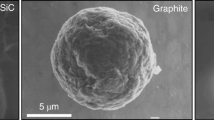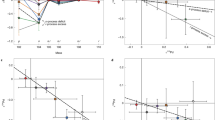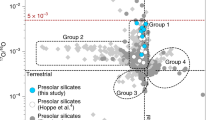Abstract
Stardust grains recovered from meteorites provide high-precision snapshots of the isotopic composition of the stellar environment in which they formed1. Attributing their origin to specific types of stars, however, often proves difficult. Intermediate-mass stars of 4–8 solar masses are expected to have contributed a large fraction of meteoritic stardust2,3. Yet, no grains have been found with the characteristic isotopic compositions expected for such stars4,5. This is a long-standing puzzle, which points to serious gaps in our understanding of the lifecycle of stars and dust in our Galaxy. Here we show that the increased proton-capture rate of 17O reported by a recent underground experiment6 leads to 17O/16O isotopic ratios that match those observed in a population of stardust grainsfor proton-burning temperatures of 60–80 MK. These temperatures are achieved at the base of the convective envelope during the late evolution of intermediate-mass stars of 4–8 solar masses7–9, which reveals them as the most likely site of origin of the grains. This result provides direct evidence that these stars contributed to the dust inventory from which the Solar System formed.
This is a preview of subscription content, access via your institution
Access options
Access Nature and 54 other Nature Portfolio journals
Get Nature+, our best-value online-access subscription
$29.99 / 30 days
cancel any time
Subscribe to this journal
Receive 12 digital issues and online access to articles
$119.00 per year
only $9.92 per issue
Buy this article
- Purchase on Springer Link
- Instant access to full article PDF
Prices may be subject to local taxes which are calculated during checkout




Similar content being viewed by others
References
Zinner, E. in Treatise on Geochemistry 2nd edn, Vol. 1 (ed. Davis, A. M. ) 181–213 (Elsevier, 2014).
Gail, H.-P., Zhukovska, S. V., Hoppe, P. & Trieloff, M. Stardust from asymptotic giant branch stars. Astrophys. J. 698, 1136–1154 (2009).
Zhukovska, S., Petrov, M. & Henning, T. Can star cluster environment affect dust input from massive AGB stars? Astrophys. J. 810, 128 (2015).
Lugaro, M. et al. On the asymptotic giant branch star origin of peculiar spinel grain OC2. Astron. Astrophys. 461, 657–664 (2007).
Iliadis, C., Angulo, C., Descouvemont, P., Lugaro, M. & Mohr, P. New reaction rate for 16O(p,γ)17F and its influence on the oxygen isotopic ratios in massive AGB stars. Phys. Rev. C 77, 045802 (2008).
Bruno, C. G. et al. Improved direct measurement of the 64.5 keV resonance strength in the 17O(p, α)14N reaction at LUNA. Phys. Rev. Lett. 117, 142502 (2016).
Ventura, P., Di Criscienzo, M., Carini, R. & D’Antona, F. Yields of AGB and SAGB models with chemistry of low- and high-metallicity globular clusters. Mon. Not. R. Astron. Soc. 431, 3642–3653 (2013).
Cristallo, S., Straniero, O., Piersanti, L. & Gobrecht, D. Evolution, nucleosynthesis, and yields of AGB stars at different metallicities. III. Intermediate-mass models, revised low-mass models, and the ph-FRUITY interface. Astrophys. J. Suppl. 219, 40 (2015).
Karakas, A. I. & Lugaro, M. Stellar yields from metal-rich asymptotic giant branch models. Astrophys. J. 825, 26 (2016).
Nittler, L. R., Alexander, C. M. O’D., Gao, X., Walker, R. M. & Zinner, E. Stellar sapphires: The properties and origins of presolar Al2O3 in meteorites. Astrophys. J. 483, 475–495 (1997).
Wood, P. R., Bessell, M. S. & Fox, M. W. Long-period variables in the Magellanic Clouds: Supergiants, AGB stars, supernova precursors, planetary nebula precursors, and enrichment of the interstellar medium. Astrophys. J. 272, 99–115 (1983).
Iliadis, C., Longland, R., Champagne, A. E., Coc, A. & Fitzgerald, R. Charged-particle thermonuclear reaction rates: II. Tables and graphs of reaction rates and probability density functions. Nucl. Phys. A 841, 31–250 (2010).
Nollett, K. M., Busso, M. & Wasserburg, G. J. Cool bottom processes on the thermally pulsing asymptotic giant branch and the isotopic composition of circumstellar dust grains. Astrophys. J. 582, 1036–1058 (2003).
Palmerini, S., La Cognata, M., Cristallo, S. & Busso, M. Deep mixing in evolved stars. I. The effect of reaction rate revisions from C to Al. Astrophys. J. 729, 3 (2011).
Nucci, M. C. & Busso, M. Magnetohydrodynamics and deep mixing in evolved stars. I. two- and three-dimensional analytical models for the asymptotic giant branch. Astrophys. J. 787, 141 (2014).
Buckner, M. Q. et al. High-intensity-beam study of 17O(p, γ)18F and thermonuclear reaction rates for 17O+p. Phys. Rev. C 91, 015812 (2015).
Justtanont, K. et al. Herschel observations of extreme OH/IR stars. The isotopic ratios of oxygen as a sign-post for the stellar mass. Astron. Astrophys. 578, A115 (2015).
Gyngard, F. et al. Automated NanoSIMS measurements of spinel stardust from the Murray meteorite. Astrophys. J. 717, 107–120 (2010).
Nittler, L. R. et al. Aluminum-, calcium- and titanium-rich oxide stardust in ordinary chondrite meteorites. Astrophys. J. 682, 1450–1478 (2008).
Straniero, O. et al. Impact of a revised 25Mg(p, γ)26Al reaction rate on the operation of the Mg-Al cycle. Astrophys. J. 763, 100 (2013).
Hynes, K. M. & Gyngard, F. In 40th Lunar and Planetary Science Conference Abstract 1198 (Lunar and Planetary Institute, 2009); http://presolar.wustl.edu/~pgd/welcome.html.
Asplund, M., Grevesse, N., Sauval, A. J. & Scott, P. The chemical composition of the Sun. Ann. Rev. Astron. Astrophys. 47, 481–522 (2009).
Karakas, A. I. Helium enrichment and carbon-star production in metal-rich populations. Mon. Not. R. Astron. Soc. 445, 347–358 (2014).
Karakas, A. I. Updated stellar yields from asymptotic giant branch models. Mon. Not. R. Astron. Soc. 403, 1413–1425 (2010).
Vassiliadis, E. & Wood, P. R. Evolution of low- and intermediate-mass stars to the end of the asymptotic giant branch with mass loss. Astrophys. J. 413, 641–657 (1993).
Marigo, P. & Aringer, B. Low-temperature gas opacity. ÆSOPUS: a versatile and quick computational tool. Astron. Astrophys. 508, 1539–1569 (2009).
Lattanzio, J. C. The asymptotic giant branch evolution of 1.0–3.0 solar mass stars as a function of mass and composition. Astrophys. J. 311, 708–730 (1986).
Longland, R., Iliadis, C. & Karakas, A. I. Reaction rates for the s-process neutron source 22Ne + α . Phys. Rev. C 85, 065809 (2012).
Acknowledgements
We thank O. Pols and R. Izzard for useful insights on binary systems and P. Marigo for discussion of our results. M.L. is a Momentum (‘Lendìlet-2014’ Programme) project leader of the Hungarian Academy of Sciences. M.L. and A.I.K. are grateful for the support of the National Computational Infrastructure National Facility at the Australian National University.
Author information
Authors and Affiliations
Contributions
M.L. designed and carried out the research, ran the nucleosynthesis models, prepared the figures, and wrote the paper. A.I.K. ran the stellar structure models, discussed the results and wrote the paper. C.G.B. played a key role in the set up and running of the underground experiment relating to the 17O(p, α)14N reaction and analysed the data to derive the new rate. M.A. contributed to running the experiment and wrote the paper. L.R.N. contributed to the collection of the stardust grain data, discussed the results, prepared the figures, and wrote the paper. The other authors are co-investigators who set up and ran the underground experiment that lasted about three years, from 2012 to 2015, and made the measurements possible. O.S. also discussed the results.
Corresponding author
Ethics declarations
Competing interests
The authors declare no competing financial interests.
Supplementary information
Supplementary Information
Supplementary Table 1 (PDF 73 kb)
Rights and permissions
About this article
Cite this article
Lugaro, M., Karakas, A., Bruno, C. et al. Origin of meteoritic stardust unveiled by a revised proton-capture rate of 17O. Nat Astron 1, 0027 (2017). https://doi.org/10.1038/s41550-016-0027
Received:
Accepted:
Published:
DOI: https://doi.org/10.1038/s41550-016-0027



